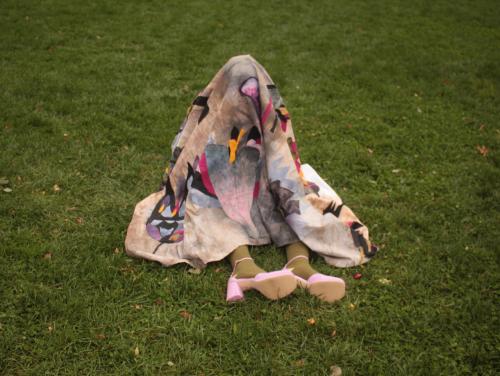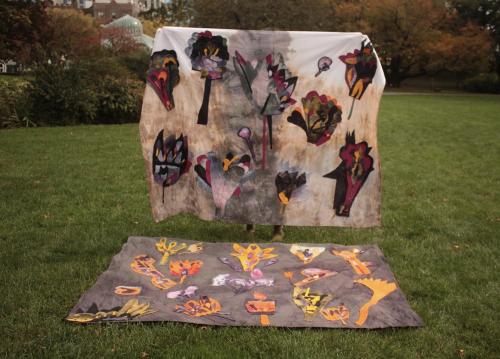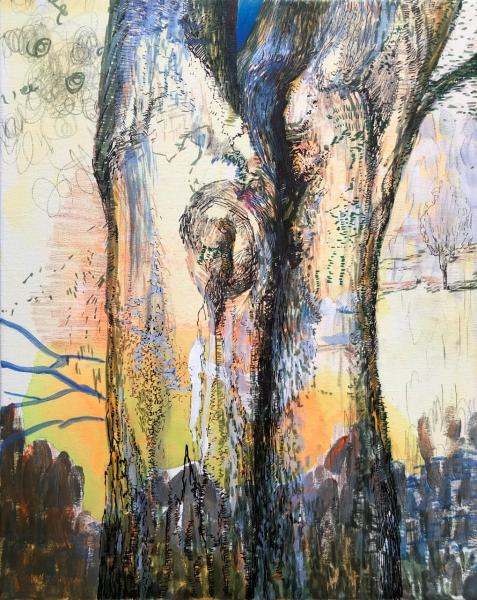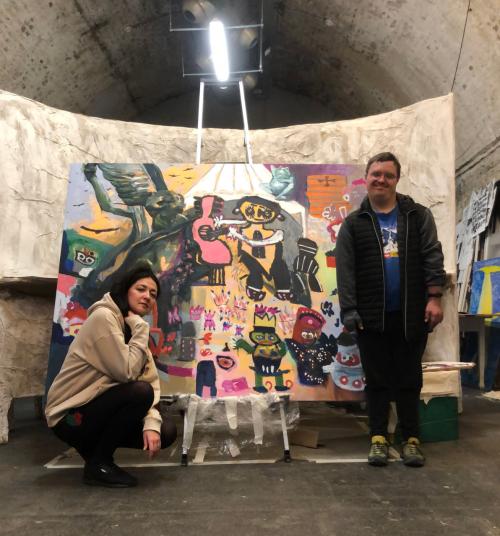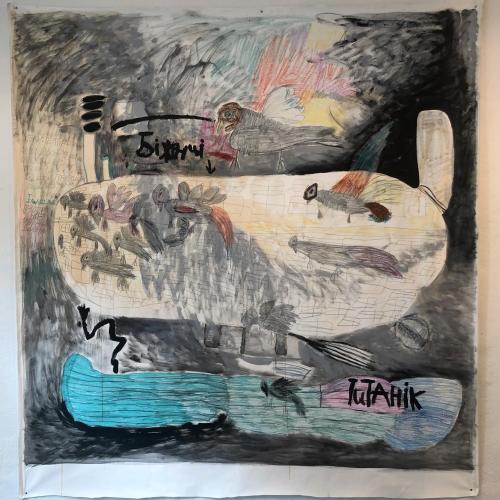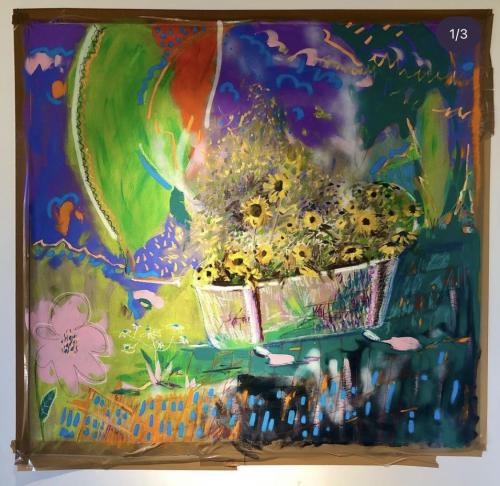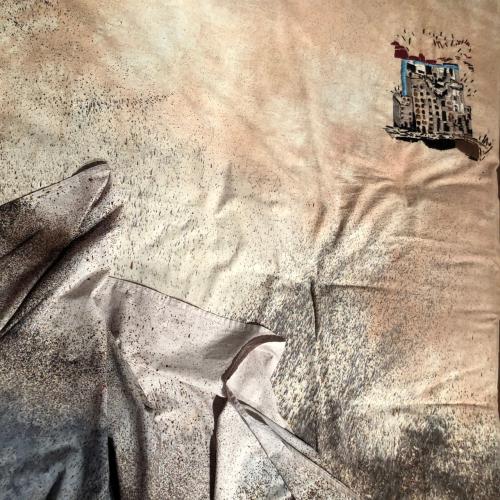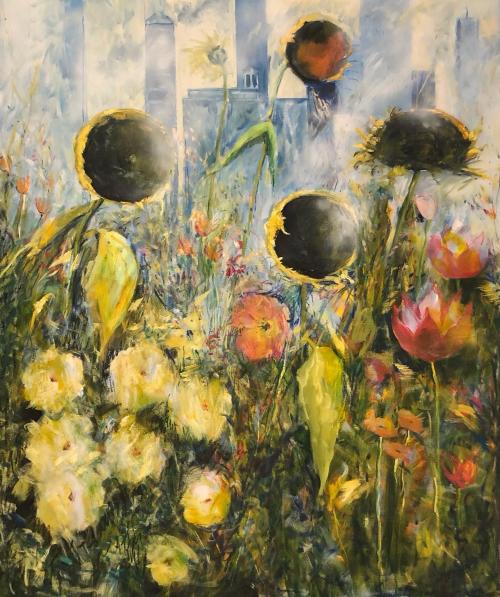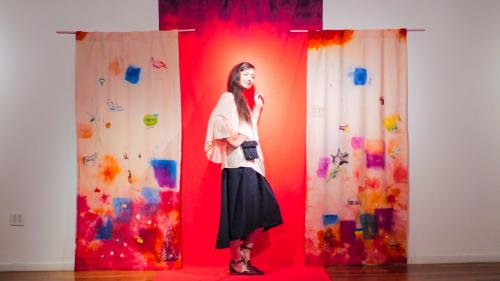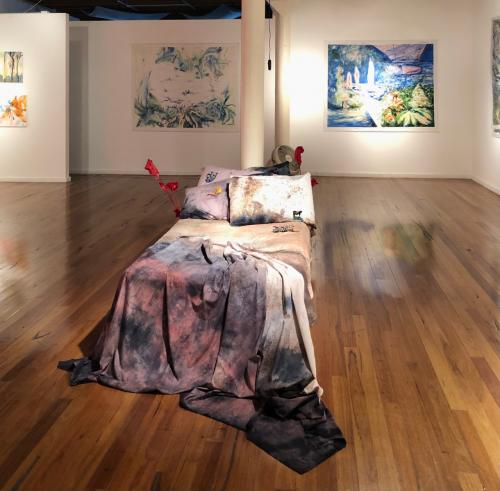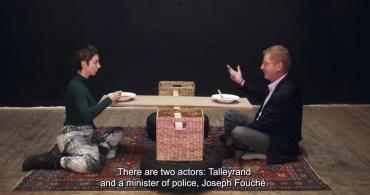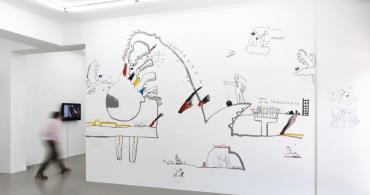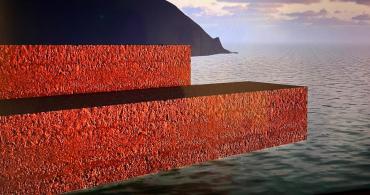The artist Valeria Tarasenko lived in Kyiv all her life until she was forced to leave the country due to the full-scale invasion. During her nearly two years abroad, she has been actively working to educate foreigners about the war and to incorporate the topic of Ukraine into local art scenes in Europe and the United States.
Tarasenko was born into a family of famous Soviet athletes - a volleyball player and a rugby player - but from the earliest years of her life, she knew that she would only be pursuing art. Since 2019, Tarasenko has been working with Atelier Normal, a studio for artists with and without disabilities, exploring the boundaries between professional and outsider art.
In the summer when this conversation took place, the artist was at a residency in Chicago, where she had just presented an exhibition about the war. Tarasenko spoke about the challenges Ukrainian art faces abroad and how to find meaning in creativity when the world falls apart in an interview with Lisa Korneichuk.
With this publication, ArtsLooker continues a series of informative essays and interviews in partnership with the Museum Of Contemporary Art NGO and UMCA (Ukrainian Museum of Modern Art) about Ukrainian art during the full-scale war in the framework of the Wartime Art Archive.
“War is not about understanding, it's about feeling”: Ukrainian artist Valeria Tarasenko on wartime art and its perception in the West
25 december, 2023
At what point did you decide that you would pursue art professionally?
When I was a child, I remember a morning like this: I woke up very early, and my parents were still asleep. I went to the kitchen and drew a lot of flowers. The whole kitchen was covered with these flowers. When my parents woke up and came in, they were shocked: “When did you have time to do that?” I said, “Well, in the morning.”
When I was seven, I was sent to an art studio and then went to art school in Berezniaky, my native neighborhood in Kyiv. In the morning, I went to a regular school, then to an art school, where I spent the whole day until nine in the evening. And so on, three times a week.
I entered the faculty of book graphics at the Igor Sikorsky Kyiv Polytechnic Institute. In my third year, I realized that I had to become a designer, but I didn't want to. I don't want to spend all day at the computer. In addition, I suddenly realized that industrial design is something so short-lived: I would draw something, and people would throw it away, you would eat something and throw away the wrapper, or you would finish a magazine and toss it. So graphic design became no longer interesting to me.
In my third year of study, I studied oil painting with a teacher at the House of Artists. After watercolors, I really liked oil painting because of the whitewashes this medium offers many opportunities. I entered the National Academy of Fine Arts and Architecture at the faculty of Painting Restoration because I wasn't ready to study painting. I was the last one to get a contract, and I paid for a year myself, as I remember now, it was 300 bucks a month. I paid and paid, then I went to the teacher Mykhailo Shapovalenko, and in six months, he taught me how to draw nude figures, so I got all A's in the last review after the first year.
When I was a child, I remember a morning like this: I woke up very early, and my parents were still asleep. I went to the kitchen and drew a lot of flowers. The whole kitchen was covered with these flowers. When my parents woke up and came in, they were shocked: “When did you have time to do that?” I said, “Well, in the morning.”
When I was seven, I was sent to an art studio and then went to art school in Berezniaky, my native neighborhood in Kyiv. In the morning, I went to a regular school, then to an art school, where I spent the whole day until nine in the evening. And so on, three times a week.
I entered the faculty of book graphics at the Igor Sikorsky Kyiv Polytechnic Institute. In my third year, I realized that I had to become a designer, but I didn't want to. I don't want to spend all day at the computer. In addition, I suddenly realized that industrial design is something so short-lived: I would draw something, and people would throw it away, you would eat something and throw away the wrapper, or you would finish a magazine and toss it. So graphic design became no longer interesting to me.
In my third year of study, I studied oil painting with a teacher at the House of Artists. After watercolors, I really liked oil painting because of the whitewashes this medium offers many opportunities. I entered the National Academy of Fine Arts and Architecture at the faculty of Painting Restoration because I wasn't ready to study painting. I was the last one to get a contract, and I paid for a year myself, as I remember now, it was 300 bucks a month. I paid and paid, then I went to the teacher Mykhailo Shapovalenko, and in six months, he taught me how to draw nude figures, so I got all A's in the last review after the first year.
You worked with Atelie Normalno, a studio that works with neurodiverse artists. How did you meet them?
It was about five years ago. After the academy, I found a studio in Podil, a very cool house, very cheap and near the Kontraktova Square metro station. I started living there, working and preparing for an exhibition. One day, the Open Group and their friends (a group of artists founded in 2012 by Anton Varga, Yurii Biley, Oleh Perkovskyi, Stanislav Turina, Pavlo Kovach, and Yevhen Samborsky — ed.) came to my place and stayed overnight. After a while, Stas Turina asked me if I wanted to substitute for him in atelie normalno for a few weeks, and I agreed because I had experience working at an art school.
Then Zhenya Golubentsev (artist with Down syndrome and winner of the Artists Prize 2021 from The Naked Room and Montblanc Kyiv -— ed.) came to my studio. I saw him painting and was shocked. I told Stas that it was so cool, and he said: “I know.” So I invited Zhenia to come to my studio to work together. And so it continued, and then other participants appeared.
It was about five years ago. After the academy, I found a studio in Podil, a very cool house, very cheap and near the Kontraktova Square metro station. I started living there, working and preparing for an exhibition. One day, the Open Group and their friends (a group of artists founded in 2012 by Anton Varga, Yurii Biley, Oleh Perkovskyi, Stanislav Turina, Pavlo Kovach, and Yevhen Samborsky — ed.) came to my place and stayed overnight. After a while, Stas Turina asked me if I wanted to substitute for him in atelie normalno for a few weeks, and I agreed because I had experience working at an art school.
Then Zhenya Golubentsev (artist with Down syndrome and winner of the Artists Prize 2021 from The Naked Room and Montblanc Kyiv -— ed.) came to my studio. I saw him painting and was shocked. I told Stas that it was so cool, and he said: “I know.” So I invited Zhenia to come to my studio to work together. And so it continued, and then other participants appeared.
You had never worked with neurodiverse artists before. What was it like for you?
I wasn't working, but I liked it right away. After an art school or academy, this approach seems very fresh. Atelie normalno members don't need to be taught how to draw. They already draw the way they know how, and it's impossible to re-train them. I really liked it. I saw that each of them has their own style. This is an approach where you listen to yourself and don't listen to anything from the outside. It's very interesting because I was taught to draw; unfortunately, I had to learn it at school. And now it's like I’m trying to forget what I learned to do what I want to do. But it's much easier for me to try something new because I already have a base to experiment with new techniques, such as ceramics or textiles. So I can't say that I'm a naive artist, and I'll never be able to become one. But I adore naïve art. I love it when people just paint and paint a lot. And they do it the way they want to.
I wasn't working, but I liked it right away. After an art school or academy, this approach seems very fresh. Atelie normalno members don't need to be taught how to draw. They already draw the way they know how, and it's impossible to re-train them. I really liked it. I saw that each of them has their own style. This is an approach where you listen to yourself and don't listen to anything from the outside. It's very interesting because I was taught to draw; unfortunately, I had to learn it at school. And now it's like I’m trying to forget what I learned to do what I want to do. But it's much easier for me to try something new because I already have a base to experiment with new techniques, such as ceramics or textiles. So I can't say that I'm a naive artist, and I'll never be able to become one. But I adore naïve art. I love it when people just paint and paint a lot. And they do it the way they want to.
You lived and worked in Kyiv all your life. But after the full-scale war, you had to leave. How has your life changed because of the war?
Now I'm in Chicago at the residency of John David Mooney (an American artist known for his sculptures in public space and light works — ed.) Before the war, I had never lived anywhere outside of Kyiv for more than a month. And I didn't want to, I was absolutely happy with my life in Kyiv. I traveled a lot around the world, but two weeks abroad and I want to go home.
After the invasion, I went to Warsaw, stayed with friends, and didn't know what to do next. They said, "Let's settle down in Warsaw, we'll find you an apartment, a studio, and you can work here. But I kept putting off settling down and traveled to residencies instead. First, it was Norway, then Spain, France, and Germany. And now I'm here. That is, this year and six months have been spent moving from one residence to another. And continuing my practice. And rethinking my whole life.
Emotionally, it's hard for me now. A person is not born for war. It is something very anti-human. I have so many friends in the army, so seeing them going through this experience and changing is painful. When a person is born, parents put a lot of effort into ensuring that they grow up healthy, get an education, and are happy. Then, the war happens. This person is conscripted or volunteers to join the army. And in the army, a different life begins one for which they were not prepared. I know that all my acquaintances and friends there are the best people. It's hard to see them lose their potential and their lives in the war.
Now I'm in Chicago at the residency of John David Mooney (an American artist known for his sculptures in public space and light works — ed.) Before the war, I had never lived anywhere outside of Kyiv for more than a month. And I didn't want to, I was absolutely happy with my life in Kyiv. I traveled a lot around the world, but two weeks abroad and I want to go home.
After the invasion, I went to Warsaw, stayed with friends, and didn't know what to do next. They said, "Let's settle down in Warsaw, we'll find you an apartment, a studio, and you can work here. But I kept putting off settling down and traveled to residencies instead. First, it was Norway, then Spain, France, and Germany. And now I'm here. That is, this year and six months have been spent moving from one residence to another. And continuing my practice. And rethinking my whole life.
Emotionally, it's hard for me now. A person is not born for war. It is something very anti-human. I have so many friends in the army, so seeing them going through this experience and changing is painful. When a person is born, parents put a lot of effort into ensuring that they grow up healthy, get an education, and are happy. Then, the war happens. This person is conscripted or volunteers to join the army. And in the army, a different life begins one for which they were not prepared. I know that all my acquaintances and friends there are the best people. It's hard to see them lose their potential and their lives in the war.
How did the nomadic state affect your understanding of this reality, how do you see your life going forward?
The reality is that no one will ever understand you until they have experienced what Ukraine is going through. Because war is not about understanding, it's about feeling. You feel this horror and can't convey it to another person. On the one hand, it seems to be easier outside of Ukraine, but in reality, it's not easier at all. But I wanted to develop artistically, and I realized that if I stayed in Kyiv, I would be stuck at home, in my apartment. Moving around the city was difficult at first. I just decided to leave, and if anything, I would return. Now whenever I want to return, my parents and friends say: “It's too early, don't come back.” But I can't imagine building my life anywhere else.
The reality is that no one will ever understand you until they have experienced what Ukraine is going through. Because war is not about understanding, it's about feeling. You feel this horror and can't convey it to another person. On the one hand, it seems to be easier outside of Ukraine, but in reality, it's not easier at all. But I wanted to develop artistically, and I realized that if I stayed in Kyiv, I would be stuck at home, in my apartment. Moving around the city was difficult at first. I just decided to leave, and if anything, I would return. Now whenever I want to return, my parents and friends say: “It's too early, don't come back.” But I can't imagine building my life anywhere else.
So now, in fact, you're trying to buy time before returning?
Yes, to gain time and improve my art a little bit. Before the invasion, I spent all my free time working in the studio and decided what to do and when to do it myself. This happens differently in different residencies, sometimes, you have to fulfill the requirements of the hosts. What I created during the year of the invasion would probably take me three years in Kyiv.
I didn't always want to do something about the war. At first, I just needed to draw what I saw on the news to relieve myself of the burden. I started drawing absolutely everything: my parents in the bomb shelter, Zhenya, whom we couldn't contact at the time, the explosions. I redrew it all, and I felt better. At that time I was constantly in the news, reading everything, analyzing everything. So, while painting, I wanted to disconnect from it, so I painted landscapes and flowers.
Now, in Chicago, I'm struck by how calmly people live here and how they make plans. So, at the final exhibition of the residency, I wanted to talk about my condition here. I talk about how I tell foreigners that I feel good here, but I don't feel good, about how I'm ashamed that they have a very cool city, but I don't enjoy it.
Yes, to gain time and improve my art a little bit. Before the invasion, I spent all my free time working in the studio and decided what to do and when to do it myself. This happens differently in different residencies, sometimes, you have to fulfill the requirements of the hosts. What I created during the year of the invasion would probably take me three years in Kyiv.
I didn't always want to do something about the war. At first, I just needed to draw what I saw on the news to relieve myself of the burden. I started drawing absolutely everything: my parents in the bomb shelter, Zhenya, whom we couldn't contact at the time, the explosions. I redrew it all, and I felt better. At that time I was constantly in the news, reading everything, analyzing everything. So, while painting, I wanted to disconnect from it, so I painted landscapes and flowers.
Now, in Chicago, I'm struck by how calmly people live here and how they make plans. So, at the final exhibition of the residency, I wanted to talk about my condition here. I talk about how I tell foreigners that I feel good here, but I don't feel good, about how I'm ashamed that they have a very cool city, but I don't enjoy it.
This exhibition is called “Anxious Pink.” In it, you experiment with techniques: you make textile works, including embroidery. Tell us more about the exhibition and why you chose this title.
This exhibition consists of two parts: one is about Ukraine now, and the other is about my feeling of Chicago, the place as it is. I was inspired by textiles after seeing local exhibitions, and I found some cool materials in an art store. In the United States, art stores are top-of-the-line, they even have textile powder there. This year, I got really tired of painting. So I started embroidering, and experimenting with textiles, and I liked it. It is impossible to embroider something quickly, it is a process, a time-based technique. If you decide to embroider something, then sit and do it. The pink color I found in the textiles here is felt disturbing to me. It became the embodiment of the anxiety I felt on February 24.
This exhibition consists of two parts: one is about Ukraine now, and the other is about my feeling of Chicago, the place as it is. I was inspired by textiles after seeing local exhibitions, and I found some cool materials in an art store. In the United States, art stores are top-of-the-line, they even have textile powder there. This year, I got really tired of painting. So I started embroidering, and experimenting with textiles, and I liked it. It is impossible to embroider something quickly, it is a process, a time-based technique. If you decide to embroider something, then sit and do it. The pink color I found in the textiles here is felt disturbing to me. It became the embodiment of the anxiety I felt on February 24.
People who care about Ukraine usually come to Ukrainian exhibitions. If they are already interested, they want to help, they are involved. For example, I had a story when a man came and asked where to donate. I offered him different fundraisers, and he chose to donate to my friend's car and sent a serious amount of money. The fact that such things happen at exhibitions is the most important for me.
Research and development of materials, Wartime Art Archive website development, and media partnership with Suspilne.Kultura and Artslooker are implemented by the Museum of Contemporary Art NGO with the support of the Fritt Ord Foundation (Norway) and the Sigrid Rausing Trust (UK).
The text in Ukrainian is available on Suspilne.Kultura.
Research and development of materials, Wartime Art Archive website development, and media partnership with Suspilne.Kultura and Artslooker are implemented by the Museum of Contemporary Art NGO with the support of the Fritt Ord Foundation (Norway) and the Sigrid Rausing Trust (UK).
The text in Ukrainian is available on Suspilne.Kultura.
To read more articles about contemporary art please support Artslooker on Patreon
Share:
